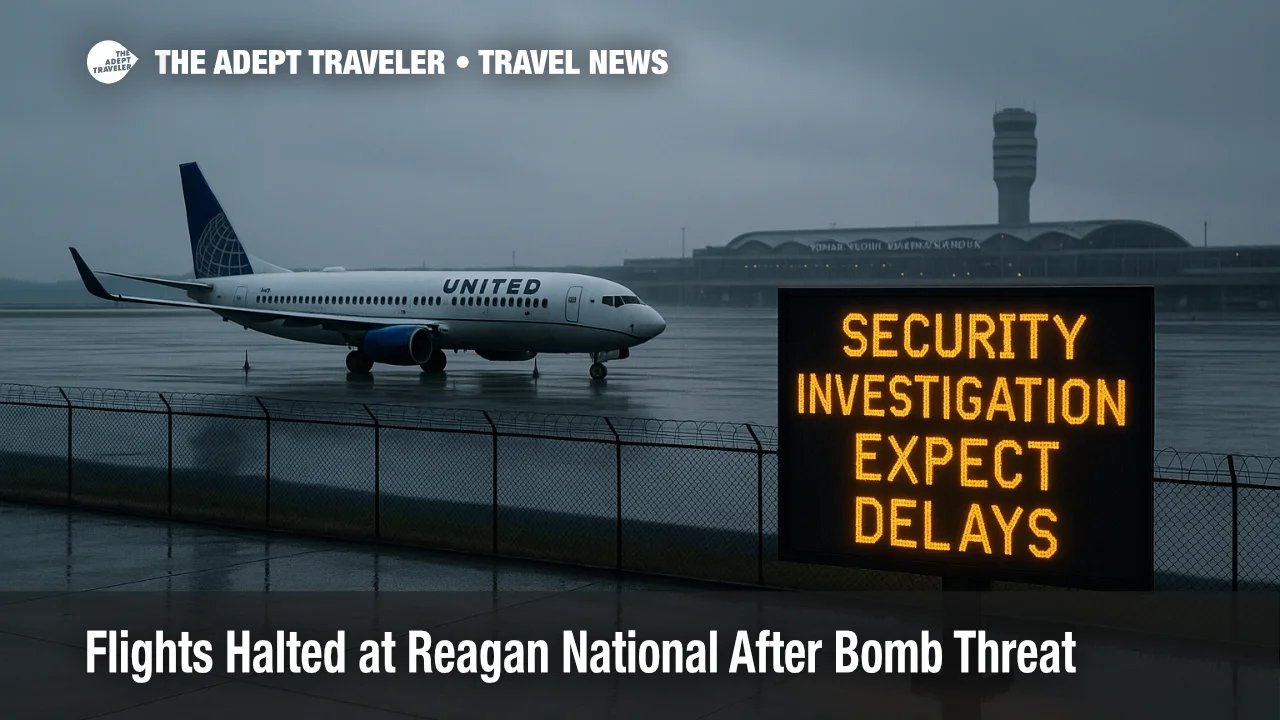Flights Halted at Reagan National After Bomb Threat

Key points
- All flights at Reagan Washington National Airport were halted Tuesday after a bomb threat targeting an arriving United Airlines flight
- Passengers were deplaned and the aircraft was isolated away from the terminal during the investigation
- Operations began resuming early afternoon with significant knock-on delays across the schedule
- Travelers reported diversions and extended tarmac times as the FAA issued a ground stop
Impact
- Expect Major Delays
- Residual disruptions will cascade through late afternoon and evening departures and arrivals
- Monitor Your Flight
- Use airline apps and airport pages for gate changes, diversions, and rebooking notices
- Pad Connections
- Add 60-90 minutes for Washington area connections and consider later trains or alternate airports
- Check Waivers
- Look for same-day change or fee-waiver options if your flight was delayed or diverted
- Allow Extra Arrival Time
- Security postures may be elevated which can slow curbside and checkpoint flows
All flights at Ronald Reagan Washington National Airport (DCA) in Arlington, Virginia, were halted on November 4 after a bomb threat was reported against an arriving United Airlines flight. The Federal Aviation Administration (FAA) issued a ground stop while authorities deplaned passengers and moved the aircraft to a remote area for inspection. The pause created immediate delays and diversions across the Washington region as the investigation unfolded, before operations began to resume in the early afternoon.
What changed for travelers
The emergency ground stop meant no departures or arrivals for part of the late morning and midday at Reagan National, the closest airport to downtown Washington, D.C. Flight-tracking services and local media recorded widespread delays, with some aircraft holding, diverting to nearby airports, or remaining on tarmacs until the halt eased. The FAA said passengers from the United flight were removed and the plane was isolated for law-enforcement checks.
Latest developments
By early afternoon, flights began moving again, though significant delays persisted as the airport worked through the backlog. Early reporting indicated more than a hundred delays tied to the stop and its recovery window, with additional ripple effects likely through the evening schedule. Officials had not released details on the credibility of the threat at the time of initial reporting.
Analysis
A security-driven ground stop at an urban airport with constrained runway capacity like Reagan National quickly cascades across banks of flights. Even a brief pause can shift crew duty windows, aircraft rotations, and gate assignments. If you are connecting in Washington today, treat all tight layovers as at risk and move to a later option if offered in-app. For origin and destination travelers, expect longer taxi-out times, gate holds, and occasional equipment swaps while operations normalize.
Background During aircraft emergencies, the FAA manages air traffic, while airport operations and law enforcement coordinate the airfield response and investigation. Bomb-threat protocols typically include deplaning, isolating the aircraft, and conducting explosive-detection sweeps, after which traffic resumes in stages as ramp space and staffing allow.
Final thoughts
The bomb threat that halted flights at Reagan National underscores how fast security events can reshape a day's schedule. If you are booked through DCA today, assume rolling delays, monitor your airline app for automatic rebooking, and add buffer time at every step.
Sources
- FAA halts traffic at Washington DC airport after threat reported against plane
- All flight operations on hold at Reagan National Airport due to 'security threat'
- Reagan Airport Flights Halted Due to United Airlines Bomb Threat
- Flights grounded at Reagan National after reported security issue, FAA says
- Emergencies at the Airports
